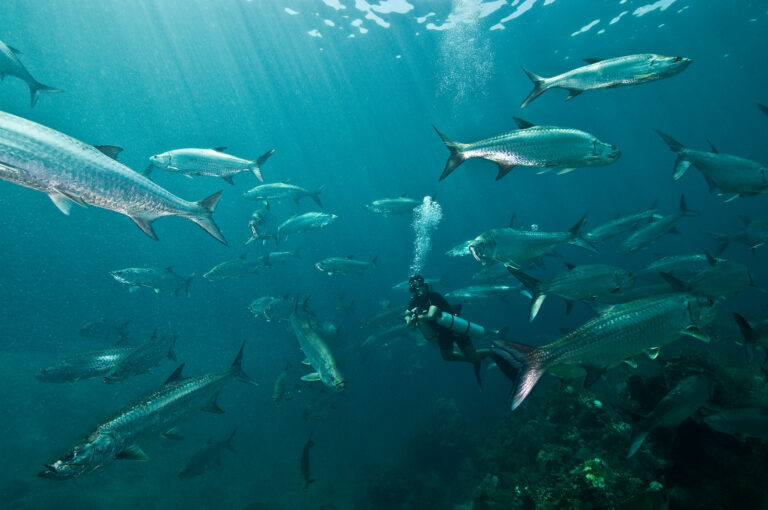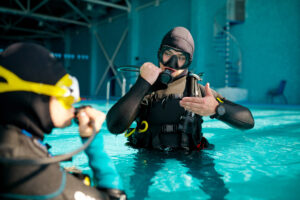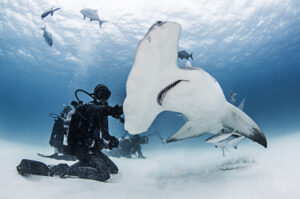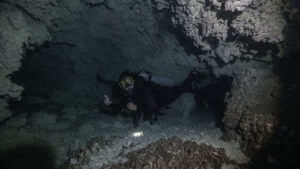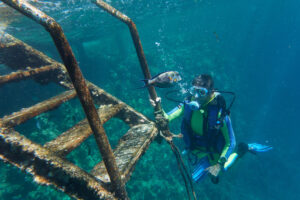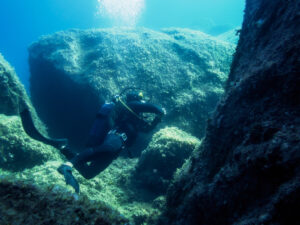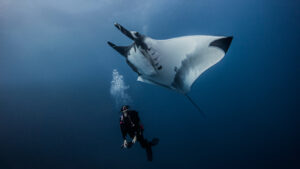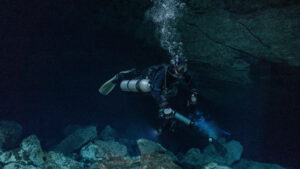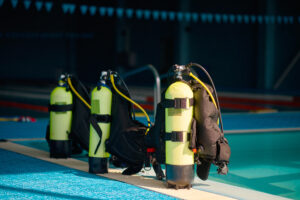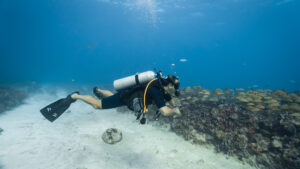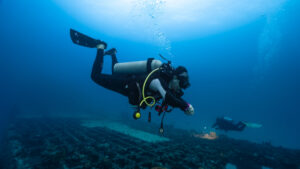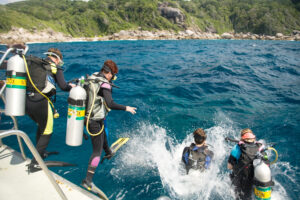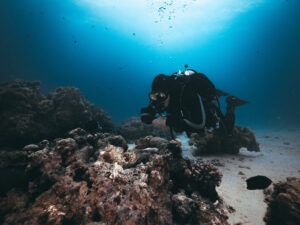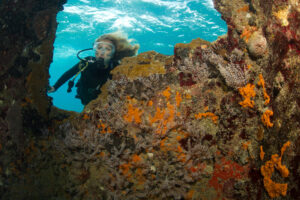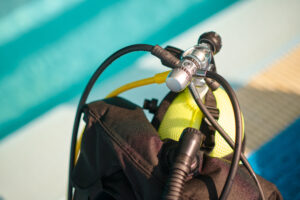What is a No Stop Dive?
A no stop dive, also known as a no decompression dive, is a type of scuba diving where divers can ascend directly to the surface without having to make mandatory decompression stops. These dives are characterized by staying within certain depth and time limits to avoid the need for decompression, which occurs when dissolved gases, primarily nitrogen, form bubbles in a diver’s body during ascent. The practice is crucial for recreational diving as it emphasizes safety and proper planning. Understanding the concept and adhering to the guidelines can prevent decompression sickness, making no stop dives a fundamental aspect of safe diving practices.
Definition and Concept
A no stop dive is defined by the ability to ascend directly to the surface without required stops for decompression. This is achieved by staying within specific limits of depth and time, known as the no decompression limit (NDL). When divers exceed these limits, they must perform decompression stops to allow the body to safely off-gas excess nitrogen. The NDL varies based on the depth of the dive; deeper dives have shorter NDLs, while shallower dives allow for longer no stop times.
The concept of no stop diving is fundamental to recreational diving. It ensures that divers do not stay underwater long enough or deep enough to require decompression stops. This simplifies dive planning and reduces the risk of decompression sickness, a potentially serious condition caused by nitrogen bubbles forming in the bloodstream and tissues. By adhering to no stop limits, divers can enjoy their underwater experience without the added complexity of managing decompression.
In contrast, decompression dives require careful planning and execution. Divers who exceed no stop limits must follow specific schedules to ascend safely, involving one or more decompression stops. This requires precise timing and depth control to allow for the safe elimination of dissolved gases. No stop dives, therefore, are considered safer and more manageable, especially for recreational divers who may not have the training or experience to conduct decompression dives.
History and Development
The history of no stop diving dates back to the early days of underwater exploration. Initially, divers relied on surface-supplied air and had limited understanding of the physiological impacts of depth and pressure. As diving technology and techniques evolved, the need for a better understanding of decompression and safe diving practices became apparent.
In the mid-20th century, the development of dive tables revolutionized underwater activities. These tables, based on research conducted by the United States Navy, provided guidelines for safe ascent profiles, including no stop limits. The introduction of these tables allowed divers to plan their dives with greater precision, significantly reducing the risk of decompression sickness.
The evolution continued with the advent of dive computers in the late 20th century. These devices provided real-time monitoring of depth and time, offering divers more accurate and flexible ways to manage their no stop limits. Dive computers have since become an essential tool for recreational divers, making it easier to adhere to safe diving practices and adjust plans on the fly based on actual dive conditions.
Significant milestones in the understanding and management of no stop dives include the development of algorithms that model gas absorption and release in the body. These algorithms, incorporated into dive computers, have improved the accuracy of no stop limits, allowing for safer and more efficient diving. Today, no stop diving is a well-established practice, underpinned by decades of research and technological advancements.
Physiology of No Stop Dives
Understanding the physiology of no stop dives is crucial for appreciating their safety and importance. When a diver descends, the pressure increases, causing more nitrogen to dissolve in their body tissues. The amount of nitrogen absorbed depends on the depth and duration of the dive. During a no stop dive, the diver stays within limits that ensure the nitrogen levels remain manageable, allowing for a direct ascent without the need for decompression stops.
Nitrogen absorption follows Henry’s Law, which states that the amount of gas dissolved in a liquid is proportional to the pressure of the gas above it. As divers descend and the pressure increases, more nitrogen dissolves in their body tissues. If the ascent is too rapid, the pressure decreases too quickly, causing nitrogen to form bubbles, which can lead to decompression sickness. By staying within no stop limits, divers ensure that their bodies can off-gas nitrogen gradually during the ascent, preventing bubble formation.
Dive tables and dive computers play a vital role in managing nitrogen levels. Dive tables provide predetermined limits for no stop times based on depth, helping divers plan their activities. Dive computers, on the other hand, offer real-time monitoring of nitrogen absorption and release, adjusting the no stop limits dynamically based on actual dive profiles. These tools are essential for maintaining safe nitrogen levels and preventing decompression sickness.
The role of safety stops, typically conducted at 3-5 meters (10-15 feet) for three to five minutes, is also worth noting. While not mandatory for no stop dives, safety stops are an added precaution to further off-gas nitrogen before surfacing. This practice enhances safety, especially after deeper or longer dives, providing an extra margin of protection against decompression sickness.
Dive Planning and Execution
Proper planning and execution are paramount for safe no stop dives. The first step in planning is to determine the maximum depth and corresponding no stop time using dive tables or a dive computer. Divers should also account for factors such as water temperature, physical exertion, and previous dives, as these can influence nitrogen absorption and the no stop limits.
Once the dive parameters are set, execution involves careful monitoring of depth and time throughout the underwater excursion. Divers must keep an eye on their dive computers or depth gauges to ensure they remain within the no stop limits. It’s crucial to maintain a slow and controlled ascent rate, typically not exceeding 9 meters (30 feet) per minute, to allow for gradual off-gassing of nitrogen.
In addition to monitoring depth and time, divers should also be aware of their breathing rate and air consumption. Efficient air management is essential, as running out of air at depth can lead to emergency situations. Divers should periodically check their air supply and ensure they have enough reserve to complete the ascent and any safety stops if necessary.
Safety stops, while not mandatory for no stop dives, are highly recommended. Conducting a safety stop at 3-5 meters (10-15 feet) for three to five minutes can provide additional off-gassing time, further reducing the risk of decompression sickness. This practice is especially important after dives close to the no stop limits or repetitive dives within a short period.
Communication and teamwork are also critical during no stop dives. Divers should maintain close proximity to their buddies, regularly check on each other’s status, and be prepared to assist if needed. Effective communication ensures that everyone is aware of their limits and can respond promptly to any issues that arise.
Equipment and Technology
The equipment used in no stop dives is designed to enhance safety and manage nitrogen levels effectively. Dive computers are the most important tool for modern divers, providing real-time data on depth, time, and nitrogen absorption. These devices use algorithms to calculate no stop limits dynamically, allowing divers to adjust their plans based on actual conditions.
Depth gauges and timers are also essential, providing a backup to dive computers. These instruments help divers monitor their depth and time, ensuring they stay within the no stop limits. Redundant systems are important in case of equipment failure, as accurate depth and time information is crucial for safe diving.
Advances in technology have significantly improved the safety and convenience of no stop diving. Modern dive computers offer features such as wireless air integration, which monitors the diver’s air supply and provides alerts for low air levels. Some computers also include GPS and digital compasses, aiding navigation and surface location.
The development of advanced algorithms has also enhanced the accuracy of no stop limits. These algorithms, based on extensive research and testing, model the absorption and release of nitrogen in the body with greater precision. This has led to safer dive profiles and reduced incidents of decompression sickness.
Other essential equipment includes buoyancy control devices (BCDs), which help divers maintain neutral buoyancy and control their ascent rates. Proper buoyancy control is critical for staying within no stop limits and avoiding rapid ascents. Regulators, which deliver air from the tank to the diver, must be well-maintained and reliable to ensure a steady air supply.
Wetsuits or drysuits are used to maintain body temperature and protect against cold water, which can affect nitrogen absorption. Cold water increases nitrogen solubility in body tissues, potentially reducing no stop limits. Proper thermal protection ensures divers can comfortably and safely stay within their planned dive parameters.
Safety Considerations
Safety is the foremost concern in no stop diving. Adhering to no stop limits is crucial to avoid decompression sickness, which can occur if divers exceed these limits and ascend too quickly. Decompression sickness, or “the bends,” is caused by nitrogen bubbles forming in the body, leading to symptoms ranging from joint pain to paralysis or even death.
To mitigate these risks, divers must plan their dives meticulously and monitor their depth and time closely. Using dive tables or computers helps ensure that divers stay within safe limits. Dive computers are particularly useful as they provide real-time updates and can adjust no stop limits based on actual dive profiles.
The importance of a controlled ascent rate cannot be overstated. Rapid ascents increase the risk of nitrogen bubbles forming, as the pressure decreases too quickly for the body to safely off-gas the absorbed nitrogen. Maintaining a slow ascent rate, typically not exceeding 9 meters (30 feet) per minute, allows for gradual nitrogen elimination and reduces the risk of decompression sickness.
Emergency procedures and protocols are vital for handling potential issues during no stop dives. Divers should be familiar with their dive plan, including emergency ascent strategies and the use of safety stops. In the event of equipment failure or other emergencies, divers should be prepared to assist their buddies and make a controlled ascent to the surface.
Training and experience play a significant role in preventing accidents. Divers should undergo proper training to understand the principles of no stop diving, including the use of dive tables and computers, buoyancy control, and emergency procedures. Ongoing education and
practice help divers maintain their skills and stay current with advancements in diving technology and safety guidelines.
Buddy systems are another important aspect of safety. Diving with a buddy provides mutual support and allows for immediate assistance in case of an emergency. Regular communication and checks between buddies ensure that both divers are aware of each other’s status and can respond promptly to any issues.
Common Misconceptions
There are several misconceptions about no stop diving that can lead to unsafe practices. One common myth is that no stop dives are completely safe and free from risks. While they are generally safer than decompression dives, they still require careful planning and adherence to guidelines. Ignoring no stop limits or failing to monitor ascent rates can still result in decompression sickness.
Another misconception is that safety stops are unnecessary for no stop dives. While not mandatory, safety stops provide an added layer of protection by allowing additional time for off-gassing nitrogen. Conducting a safety stop at 3-5 meters (10-15 feet) for three to five minutes is a prudent practice, especially after dives close to the no stop limits or repetitive dives.
Some divers believe that dive computers eliminate the need for dive planning. While dive computers provide real-time data and adjust no stop limits dynamically, they should not replace thorough pre-dive planning. Understanding the dive profile, setting maximum depth and time limits, and being aware of environmental factors are all essential components of a safe dive plan.
Misunderstandings about ascent rates can also lead to unsafe practices. Some divers may think that a faster ascent is acceptable as long as they stay within the no stop limits. However, maintaining a slow and controlled ascent rate is crucial to allow for proper off-gassing of nitrogen and prevent decompression sickness.
Educational efforts and proper training are essential to dispel these misconceptions and promote safe diving practices. Divers should seek accurate information and guidance from certified instructors and reputable sources. Understanding the principles of no stop diving and adhering to established guidelines helps ensure a safe and enjoyable underwater experience.
Case Studies and Examples
Real-life examples of no stop dives highlight the importance of proper planning and execution. One notable case involved a group of recreational divers who successfully conducted a series of no stop dives over a weekend. By carefully monitoring their depth and time, using dive computers, and performing safety stops, they completed their dives without any incidents, demonstrating the effectiveness of adhering to no stop limits.
In another case, a diver experienced symptoms of decompression sickness after a no stop dive. Investigation revealed that the diver had ascended too quickly, exceeding the recommended ascent rate. This incident underscores the critical importance of a controlled ascent and following safety protocols, even when staying within no stop limits.
Positive outcomes from no stop dives are also common. Divers who follow guidelines and use proper equipment often report enjoyable and safe experiences. For example, a dive club conducted an expedition with multiple no stop dives, carefully planning each dive and using advanced dive computers to monitor nitrogen levels. Their meticulous approach resulted in a successful and incident-free trip, showcasing the benefits of proper planning and adherence to no stop diving principles.
These case studies and examples emphasize the significance of understanding and following no stop diving guidelines. They illustrate both the potential risks and the positive outcomes achievable through diligent planning, monitoring, and execution. Learning from these experiences can help divers enhance their skills and maintain safety in their underwater activities.
Key Takeaways
No stop dives are a fundamental aspect of recreational diving, emphasizing safety and proper planning. By staying within specific depth and time limits, divers can ascend directly to the surface without the need for decompression stops, reducing the risk of decompression sickness. Understanding the principles of no stop diving, using appropriate equipment, and adhering to guidelines are essential for a safe and enjoyable underwater experience.

